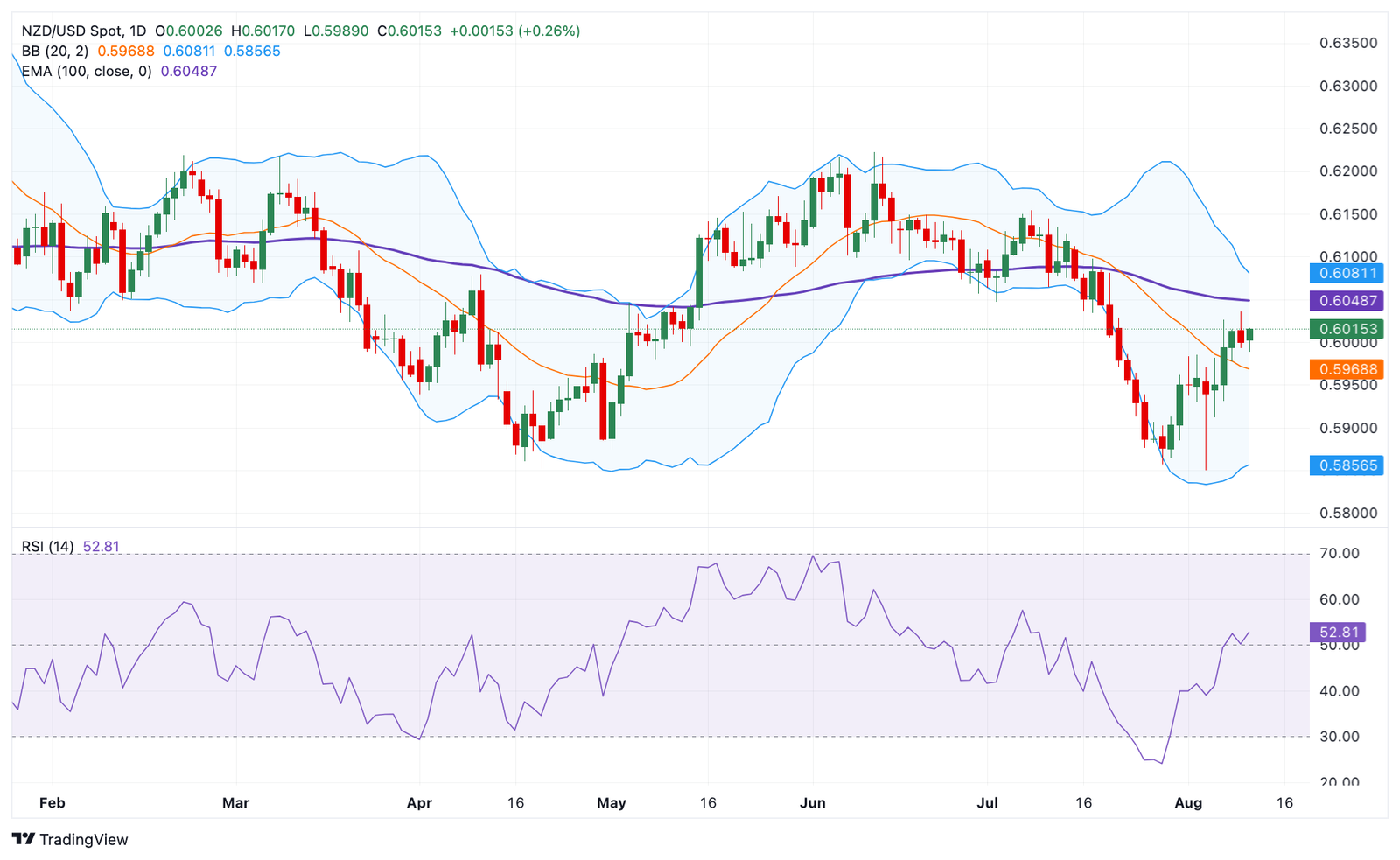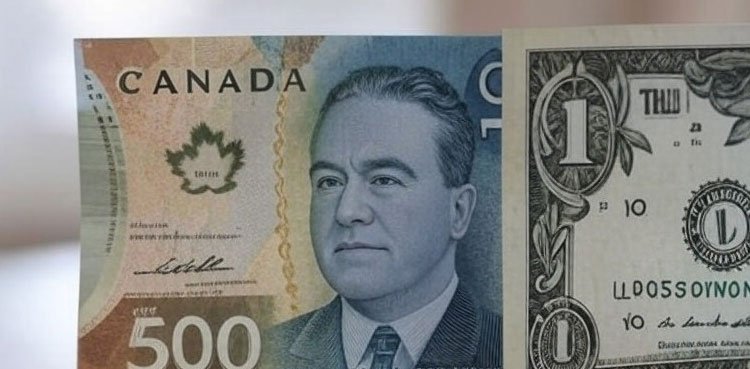- The New Zealand Dollar gains traction in Monday’s early Asian session.
- Diminishing odds of an RBNZ rate cut and hotter Chinese inflation data underpin the Kiwi.
- The RBNZ monetary policy meeting will take center stage on Wednesday.
The New Zealand Dollar (NZD) attracts some buyers to near the 0.6000 psychological level on Monday. The Kiwi gains traction as markets trimmed bets on a rate cut by the Reserve Bank of New Zealand (RBNZ) at its August meeting on Wednesday after the stronger-than-expected employment report. Furthermore, the hotter Chinese July Consumer Price Index (CPI) supports the China-proxy NZD as China is New Zealand’s largest trading partner.
Nonetheless, the heightened volatility and elevated geopolitical risks in the Middle East might exert some selling pressure on riskier assets like the Kiwi and cap the pair’s upside. Traders await the RBNZ interest rate decision on Wednesday for fresh catalysts. On the US docket, the Producer Price Index (PPI), Consumer Price Index (CPI) and Retail Sales will be released on Tuesday, Wednesday and Thursday, respectively.
Daily Digest Market Movers: New Zealand Dollar trades stronger as traders trimmed bets on RBNZ rate cut
- 12 of 21 economists surveyed by Bloomberg expect the New Zealand central bank to keep the OCR at 5.5% on Wednesday.
- The NZIER Shadow Board is split on whether the Reserve Bank of New Zealand (RBNZ) should lower the Official Cash Rate (OCR) in its forthcoming August Monetary Policy Statement.
- Over half of the Shadow Board members expect a 25 bps reduction in the OCR required due to the persistent weakening of the New Zealand economy. The other members suggested that the Reserve Bank should keep the OCR at 5.50%.
- China’s CPI climbed 0.5% year-on-year in July, compared to a 0.2% increase in June, hotter than the expectations of a 0.3% rise, the National Bureau of Statistics of China reported on Friday. On a monthly basis, Chinese CPI inflation arrived at 0.5% MoM in July versus -0.2% prior, above the consensus of 0.3%.
- Fed Governor Michelle Bowman stated on Sunday that she still sees upside risks for inflation and continued strength in the labor market, highlighting the Fed may not be ready to cut rates at its upcoming meeting in September, per Reuters.
- Traders have priced in nearly 52.5% odds that the Fed will cut the rate by 50 basis points (bps) in the September meeting, down from 57.5% last week, according to the CME FedWatch Tool.
Technical Analysis: New Zealand Dollar remains bearish in the longer term
The New Zealand Dollar edges higher on the day. However, the NZD/USD pair keeps the bearish vibe on the daily timeframe, characterized by the price remaining below the key 100-day Exponential Moving Average (EMA). The 14-day Relative Strength Index (RSI) stands in the neutral territory, hovering around the 50 midline. This suggests that the price might face consolidation before making a decisive move.
In the bullish scenario, the 100-period EMA near 0.6050 acts as an immediate resistance level for NZD/USD. Further north, this may pave the way for a move towards 0.6080, the upper boundary of the Bollinger Band. The additional upside filter to watch is 0.6134, a high of July 9.
If sellers regain control, we could see a pullback towards 0.5912, a low of August 6. Sustained trading below the mentioned level could drag the pair to 0.5856, a low of July 29 and the lower limit of the Bollinger Band.
US Dollar price today
The table below shows the percentage change of US Dollar (USD) against listed major currencies today. US Dollar was the weakest against the New Zealand Dollar.
| USD | EUR | GBP | CAD | AUD | JPY | NZD | CHF | |
| USD | -0.08% | -0.09% | -0.05% | -0.26% | -0.16% | -0.34% | -0.04% | |
| EUR | 0.10% | 0.02% | 0.05% | -0.14% | -0.05% | -0.23% | 0.06% | |
| GBP | 0.09% | 0.00% | 0.04% | -0.17% | -0.07% | -0.25% | 0.03% | |
| CAD | 0.06% | -0.03% | -0.02% | -0.19% | -0.10% | -0.28% | 0.01% | |
| AUD | 0.26% | 0.16% | 0.16% | 0.18% | 0.08% | -0.10% | 0.19% | |
| JPY | 0.17% | 0.07% | 0.06% | 0.09% | -0.10% | -0.18% | 0.11% | |
| NZD | 0.33% | 0.24% | 0.24% | 0.28% | 0.08% | 0.16% | 0.28% | |
| CHF | 0.06% | -0.02% | -0.02% | 0.01% | -0.19% | -0.10% | -0.28% |
The heat map shows percentage changes of major currencies against each other. The base currency is picked from the left column, while the quote currency is picked from the top row. For example, if you pick the Euro from the left column and move along the horizontal line to the Japanese Yen, the percentage change displayed in the box will represent EUR (base)/JPY (quote).
New Zealand Dollar FAQs
The New Zealand Dollar (NZD), also known as the Kiwi, is a well-known traded currency among investors. Its value is broadly determined by the health of the New Zealand economy and the country’s central bank policy. Still, there are some unique particularities that also can make NZD move. The performance of the Chinese economy tends to move the Kiwi because China is New Zealand’s biggest trading partner. Bad news for the Chinese economy likely means less New Zealand exports to the country, hitting the economy and thus its currency. Another factor moving NZD is dairy prices as the dairy industry is New Zealand’s main export. High dairy prices boost export income, contributing positively to the economy and thus to the NZD.
The Reserve Bank of New Zealand (RBNZ) aims to achieve and maintain an inflation rate between 1% and 3% over the medium term, with a focus to keep it near the 2% mid-point. To this end, the bank sets an appropriate level of interest rates. When inflation is too high, the RBNZ will increase interest rates to cool the economy, but the move will also make bond yields higher, increasing investors’ appeal to invest in the country and thus boosting NZD. On the contrary, lower interest rates tend to weaken NZD. The so-called rate differential, or how rates in New Zealand are or are expected to be compared to the ones set by the US Federal Reserve, can also play a key role in moving the NZD/USD pair.
Macroeconomic data releases in New Zealand are key to assess the state of the economy and can impact the New Zealand Dollar’s (NZD) valuation. A strong economy, based on high economic growth, low unemployment and high confidence is good for NZD. High economic growth attracts foreign investment and may encourage the Reserve Bank of New Zealand to increase interest rates, if this economic strength comes together with elevated inflation. Conversely, if economic data is weak, NZD is likely to depreciate.
The New Zealand Dollar (NZD) tends to strengthen during risk-on periods, or when investors perceive that broader market risks are low and are optimistic about growth. This tends to lead to a more favorable outlook for commodities and so-called ‘commodity currencies’ such as the Kiwi. Conversely, NZD tends to weaken at times of market turbulence or economic uncertainty as investors tend to sell higher-risk assets and flee to the more-stable safe havens.








